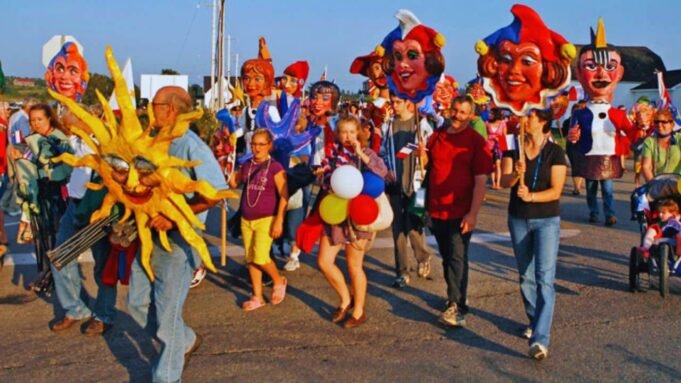National Acadian Day, celebrated on August 15, honors the rich heritage and resilience of the Acadian people, descendants of French settlers who established Canada’s first permanent European settlement in 1605.
Held in regions like Nova Scotia, New Brunswick, and Prince Edward Island, this day coincides with the Feast of the Assumption of Mary and celebrates Acadian culture through festivals, food, and traditions.
Despite the Great Upheaval’s challenges, Acadian identity thrives, reflected in their unique French dialect and tricolor flag. Unlike competitors, this guide dives deep into history, celebrations, and cultural significance. In this article, I will share insights on Acadian history, celebration ideas, key events, and more to honor National Acadian Day.
When Is National Acadian Day 2025?
National Acadian Day 2025 is celebrated on August 15, a Friday. This date, coinciding with the Feast of the Assumption of Mary, honors the Acadian people’s heritage in regions like Nova Scotia, New Brunswick, and Prince Edward Island. The mid-August timing is perfect for summer festivals, parades, and community gatherings that showcase Acadian culture.
What Is the History of National Acadian Day?
National Acadian Day, established in 1881 at the first National Convention of the Acadians in Memramcook, New Brunswick, celebrates the heritage of French settlers who founded Port Royal in 1605, Canada’s first permanent European settlement. The Great Upheaval (1755–1763) saw thousands of Acadians deported by the British, with many resettling in Louisiana (forming Cajun culture) or returning later.
The August 15 date, chosen over Saint-Jean-Baptiste Day, aligns with the Feast of the Assumption, supported by Abbot Marcel-François Richard and approved by the Vatican in 1938. In 1884, Acadians adopted a tricolor flag. A 2003 Royal Proclamation made it an official Canadian holiday, acknowledging past wrongs.
Related: National Sisters Day
How Can You Celebrate National Acadian Day 2025?
Celebrating National Acadian Day on August 15, 2025, is a vibrant way to honor Acadian culture. Here are engaging ways to participate:
- Attend Acadian festivals like the Congrès Mondial Acadien or local events in Clare, Argyle, or Grand-Pré.
- Enjoy traditional Acadian foods like poutine râpée, fricot, or rappie pie at community gatherings.
- Learn about Acadian history through books, documentaries, or museum visits, such as the Acadian Museum in Moncton.
- Share stories, photos, or recipes on social media using #NationalAcadianDay to connect with others.
- Participate in flag-raising ceremonies or cultural workshops to celebrate Acadian pride.
Consider virtual events or sustainable practices, like supporting local Acadian artisans, for a meaningful celebration.
What Are the Best Activities for National Acadian Day?
Make National Acadian Day 2025 unforgettable with these activities showcasing Acadian heritage:
- Join a tintamarre, a lively parade where participants make noise with pots, pans, and bells to celebrate the Acadian spirit.
- Visit historical sites like Port Royal or Grand-Pré National Historic Site to explore early Acadian settlements.
- Attend Acadian cultural workshops, such as cooking poutine râpée or learning traditional weaving techniques.
- Explore art exhibits or performances, like Acadian fiddle music or storytelling, at festivals in Nova Scotia or New Brunswick.
- Take a virtual tour of Acadian regions, such as the UNESCO-listed Fundy Biosphere Reserve, for remote participation.
These activities highlight Acadian resilience and traditions, perfect for locals and visitors alike.
Read More: National Raspberry Cream Pie Day 2025
What Are Key Acadian Cultural Contributions?

Acadian culture has shaped Canada’s identity through unique contributions:
- Chiac Dialect: A blend of 17th-century French, English, and Indigenous words, spoken in regions like Moncton, preserving linguistic heritage.
- Traditional Foods: Dishes like rappie pie, poutine râpée, and fricot reflect resourcefulness and French culinary roots.
- Tricolor Flag: Adopted in 1884, it symbolizes Acadian identity with blue, white, and red stripes and a gold star for Mary.
- Literature and Storytelling: Works like Longfellow’s Evangeline highlight Acadian resilience and diaspora experiences.
- Community Spirit: Acadian festivals and gatherings strengthen Canada’s multicultural mosaic, fostering unity and pride.
These contributions, rooted in history and resilience, continue to thrive in modern Canada.
What Are Some Fun Facts About National Acadian Day?
Here are five engaging facts about National Acadian Day and Acadian culture to share on August 15:
- Port Royal, established in 1605, was Acadia’s first capital and Canada’s earliest permanent European settlement.
- The name “Acadia” may come from “Quoddy,” an Indigenous term for an open sailboat, reflecting the region’s maritime roots.
- Chiac, an Acadian dialect, mixes 17th-century French with English and Indigenous words, unique to areas like Moncton.
- In 2003, a Royal Proclamation apologized for the Great Upheaval, acknowledging the forced deportation of 11,500 Acadians from 1755 to 1763.
- The Congrès Mondial Acadien, launched in 1994, unites Acadians globally every five years, with events like the 2024 edition in Nova Scotia.
These facts highlight the rich history and resilience celebrated on National Acadian Day.
Read more: Kadooment Day 2025
What Are the Dates for National Acadian Day 2026, 2027, 2028, 2029, and 2030?
National Acadian Day is celebrated annually on August 15, aligning with the Feast of the Assumption of Mary and vibrant summer festivals. Below is a table of future dates for planning your celebrations:
| Year | Date | Day |
| 2026 | August 15 | Saturday |
| 2027 | August 15 | Sunday |
| 2028 | August 15 | Tuesday |
| 2029 | August 15 | Wednesday |
| 2030 | August 15 | Thursday |
These dates offer opportunities for festivals, tintamarre parades, and cultural events in Acadian regions like Nova Scotia and New Brunswick, ensuring year-round planning for honoring Acadian heritage.
Read Also: National White Wine Day
What Is the Significance of the Acadian Dialect and Language Preservation?
The Acadian dialect and language preservation are central to Acadian identity:
- Chiac and Acadian French: Chiac, spoken in areas like Moncton, blends 17th-century French with English and Indigenous words, preserving historical linguistic roots.
- Educational Efforts: Schools in Nova Scotia and New Brunswick offer Acadian French programs to teach children the dialect and maintain cultural heritage.
- Cultural Festivals: Events like the Congrès Mondial Acadien feature storytelling, poetry, and theater in Acadian French, promoting language use.
- Challenges: English dominance and modernization threaten the dialect, but community initiatives and media (e.g., Acadian radio) counter these pressures.
- Significance: Language preservation strengthens Acadian pride and connects modern generations to their ancestors’ resilience post-Great Upheaval.
These efforts ensure Acadian French remains a vibrant part of Canada’s cultural mosaic.
Read Also: National White Wine Day
Frequently Asked Questions (FAQs)
National Acadian Day 2025 is a celebration of Acadian culture, history, and heritage. This FAQ section answers common questions about its origins, traditions, and how it’s observed, helping you better understand and appreciate this vibrant and meaningful holiday.
What is the Great Upheaval?
The Great Upheaval (1755–1763) was the forced deportation of 11,500 Acadians by the British from Nova Scotia, New Brunswick, and Prince Edward Island, with many resettling in Louisiana or returning later.
Why is National Acadian Day on August 15?
August 15 was chosen in 1881 for its alignment with the Feast of the Assumption of Mary, favored over Saint-Jean-Baptiste Day, and approved by the Vatican in 1938.
What is the Acadian tricolor flag?
Adopted in 1884, it features blue, white, and red stripes with a gold star, symbolizing Acadian identity and devotion to Mary.
How is Acadian culture different from Quebec’s French culture?
Acadian culture, rooted in early settlements like Port Royal, has a distinct dialect (Chiac), maritime traditions, and unique foods like rappie pie, unlike Quebec’s broader French-Canadian identity.
What are traditional Acadian foods?
Traditional dishes include poutine râpée (potato dumplings), fricot (meat stew), and rappie pie (grated potato and meat pie), reflecting French and local influences.
Where can I attend Acadian festivals?
Attend events in Nova Scotia (Clare, Argyle, Grand-Pré), New Brunswick (Moncton, Caraquet), or the Congrès Mondial Acadien, held every five years.
Conclusion
National Acadian Day on August 15, 2025, celebrates the enduring heritage of the Acadian people, French settlers who shaped Canada’s early history despite the Great Upheaval’s challenges. From the vibrant Chiac dialect to traditional foods like poutine râpée, Acadian culture thrives in festivals, tintamarre parades, and community gatherings.
The day, marked by the 1884 tricolor flag and global events like the Congrès Mondial Acadien, honors resilience and identity. Join the celebration by attending events, exploring historical sites, or sharing stories with #NationalAcadianDay. This day unites communities, preserving Acadian contributions to Canada’s cultural tapestry for future generations.
















[…] Related: National Acadian Day […]
[…] Read Also: National Acadian Day […]
Comments are closed.